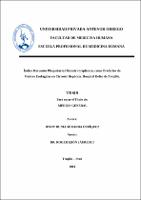| dc.contributor.advisor | León Jáuregui, Roger | |
| dc.contributor.author | Miranda Enríquez, Jenny Dunia | |
| dc.creator | Miranda Enríquez, Jenny Dunia | |
| dc.date.accessioned | 2014-11-25T20:28:19Z | |
| dc.date.available | 2014-11-25T20:28:19Z | |
| dc.date.issued | 2014 | |
| dc.identifier.uri | https://hdl.handle.net/20.500.12759/512 | |
| dc.description.abstract | Demostrar si el índice Recuento Plaquetario/Diámetro Esplénico, tiene valor como predictor de várices esofágicas en cirrosis hepática. Hospital Belén de Trujillo, en el periodo Enero 2010- Diciembre 2013.
MATERIAL Y MÉTODOS: Estudio de pruebas diagnósticas, retrospectivo, observacional, en 64 pacientes con cirrosis hepática. Se calculó la sensibilidad, especificidad, valor predictivo positivo y negativo para determinar aquel que ofreciera mayor validez predictiva de várices esofágicas. Se aplicó el test de chi cuadrado y área bajo la curva.
RESULTADOS: El mejor punto de corte del índice recuento plaquetario/diámetro esplénico, fue 1000 correspondiéndole una sensibilidad, especificidad, valor predictivo positivo y negativo de 63%, 91%, 87%, 71%; respectivamente. El área bajo la curva fue de 0.85.
CONCLUSIONES: El punto de corte de 1000 del índice recuento plaquetario/diámetro esplénico, ofrece el mejor perfil predictivo con una gran significancia estadística para várices esofágicas. El área bajo la curva calculada le confiere exactitud intermedia. | es_PE |
| dc.description.abstract | Determine the ability of platelet count/esplenic diameter index to
predict esophageal varixs at cirrhotics in Trujillo Belen Hospital.
MATERIAL AND METHODS: Retrospective, observational, diagnosis test
study to aplicatein 64cirrhotics. We calculated the sensivity, specificity,
positive and negative predictive value to esophageal varixs. We calculated the
chi square test and the area under the curve.
RESULTS: The best cut off value to platelet count/esplenic diameter index
1000and sensibility, specificity, positive and negative predictive value was
63%, 91%, 87%, 71% respectively. The under the curve area were 0.85.
CONCLUSIONS: The best cut off value platelet count/esplenic diameter
index was 1000 and this offers the better predictive value with a great
estadistical significance to esophageal varixs. The under the curve area offer an
intermedium degree of exactitude. | en_US |
| dc.description.uri | Tesis | es_PE |
| dc.format | application/pdf | es_PE |
| dc.language.iso | spa | es_PE |
| dc.publisher | Universidad Privada Antenor Orrego | es_PE |
| dc.rights | info:eu-repo/semantics/openAccess | es_PE |
| dc.rights.uri | https://creativecommons.org/licenses/by/4.0/ | es_PE |
| dc.source | Universidad Privada Antenor Orrego | es_PE |
| dc.source | Repositorio Institucional - UPAO | es_PE |
| dc.subject | Cirrosis hepática | es_PE |
| dc.subject | Varices esofágicas | es_PE |
| dc.title | Índice recuento plaquetario/diámetro esplénico, como predictor de várices esofágicas en cirrosis hepática. hospital Belén de Trujillo | es_PE |
| dc.type | info:eu-repo/semantics/bachelorThesis | es_PE |
| thesis.degree.level | Título Profesional | es_PE |
| thesis.degree.grantor | Universidad Privada Antenor Orrego. Facultad de Medicina Humana | es_PE |
| thesis.degree.name | Médico Cirujano | es_PE |
| thesis.degree.discipline | Medicina Humana | es_PE |
| dc.subject.ocde | https://purl.org/pe-repo/ocde/ford#3.02.27 | es_PE |
| renati.type | https://purl.org/pe-repo/renati/type#tesis | es_PE |
| renati.level | https://purl.org/pe-repo/renati/level#tituloProfesional | es_PE |
| renati.discipline | 912016 | es_PE |
| dc.publisher.country | PE | es_PE |


